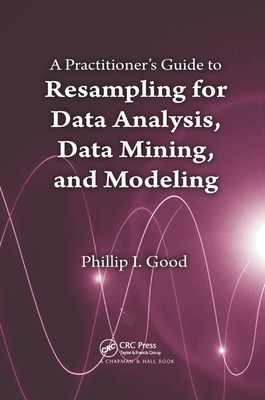
- We will send in 10–14 business days.
- Author: Phillip Good
- Publisher: CRC Press
- ISBN-10: 0367382482
- ISBN-13: 9780367382483
- Format: 15.2 x 23.1 x 1.3 cm, softcover
- Language: English
- SAVE -10% with code: EXTRA
A Practitioner's Guide to Resampling for Data Analysis, Data Mining, and Modeling (e-book) (used book) | bookbook.eu
Reviews
Description
Distribution-free resampling methods--permutation tests, decision trees, and the bootstrap--are used today in virtually every research area. A Practitioner's Guide to Resampling for Data Analysis, Data Mining, and Modeling explains how to use the bootstrap to estimate the precision of sample-based estimates and to determine sample size, data permutations to test hypotheses, and the readily-interpreted decision tree to replace arcane regression methods.
Highlights
- Each chapter contains dozens of thought provoking questions, along with applicable R and Stata code
- Methods are illustrated with examples from agriculture, audits, bird migration, clinical trials, epidemiology, image processing, immunology, medicine, microarrays and gene selection
- Lists of commercially available software for the bootstrap, decision trees, and permutation tests are incorporated in the text
- Access to APL, MATLAB, and SC code for many of the routines is provided on the author's website
- The text covers estimation, two-sample and k-sample univariate, and multivariate comparisons of means and variances, sample size determination, categorical data, multiple hypotheses, and model building
Statistics practitioners will find the methods described in the text easy to learn and to apply in a broad range of subject areas from A for Accounting, Agriculture, Anthropology, Aquatic science, Archaeology, Astronomy, and Atmospheric science to V for Virology and Vocational Guidance, and Z for Zoology.
Practitioners and research workers and in the biomedical, engineering and social sciences, as well as advanced students in biology, business, dentistry, medicine, psychology, public health, sociology, and statistics will find an easily-grasped guide to estimation, testing hypotheses and model building.
EXTRA 10 % discount with code: EXTRA
The promotion ends in 16d.12:56:24
The discount code is valid when purchasing from 10 €. Discounts do not stack.
- Author: Phillip Good
- Publisher: CRC Press
- ISBN-10: 0367382482
- ISBN-13: 9780367382483
- Format: 15.2 x 23.1 x 1.3 cm, softcover
- Language: English English
Distribution-free resampling methods--permutation tests, decision trees, and the bootstrap--are used today in virtually every research area. A Practitioner's Guide to Resampling for Data Analysis, Data Mining, and Modeling explains how to use the bootstrap to estimate the precision of sample-based estimates and to determine sample size, data permutations to test hypotheses, and the readily-interpreted decision tree to replace arcane regression methods.
Highlights
- Each chapter contains dozens of thought provoking questions, along with applicable R and Stata code
- Methods are illustrated with examples from agriculture, audits, bird migration, clinical trials, epidemiology, image processing, immunology, medicine, microarrays and gene selection
- Lists of commercially available software for the bootstrap, decision trees, and permutation tests are incorporated in the text
- Access to APL, MATLAB, and SC code for many of the routines is provided on the author's website
- The text covers estimation, two-sample and k-sample univariate, and multivariate comparisons of means and variances, sample size determination, categorical data, multiple hypotheses, and model building
Statistics practitioners will find the methods described in the text easy to learn and to apply in a broad range of subject areas from A for Accounting, Agriculture, Anthropology, Aquatic science, Archaeology, Astronomy, and Atmospheric science to V for Virology and Vocational Guidance, and Z for Zoology.
Practitioners and research workers and in the biomedical, engineering and social sciences, as well as advanced students in biology, business, dentistry, medicine, psychology, public health, sociology, and statistics will find an easily-grasped guide to estimation, testing hypotheses and model building.


Reviews